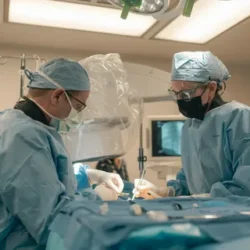In the quest for youthful skin and healthy hair, GHK-Cu peptide has emerged as one of the most powerful molecules in regenerative medicine and cosmetic science. Known for its ability to repair, rejuvenate, and stimulate cellular processes, GHK-Cu is often called the “gold standard” in peptide therapy for skin and hair regeneration. This guide explains what GHK-Cu is, how it works, and why it is widely used in modern anti-aging and hair restoration treatments.
What is GHK-Cu?
GHK-Cu is a naturally occurring copper peptide made of three amino acids—glycine, histidine, and lysine—combined with a copper ion. It was discovered in the 1970s and is present in human plasma, saliva, and urine, but its levels decrease with age. This decline is linked to visible signs of aging, including wrinkles, thinning hair, and slower wound healing. Copper peptides like GHK-Cu play an important role in the body’s natural repair and regenerative processes. They act as signaling molecules that influence gene expression, support tissue remodeling, and boost the production of essential structural proteins such as collagen and elastin.
How GHK-Cu Works
GHK-Cu stimulates skin and hair regeneration at the cellular level in multiple ways. It promotes collagen and elastin production by activating fibroblasts, the cells responsible for these proteins, which helps improve skin texture, reduce fine lines, and enhance firmness. It accelerates wound healing by increasing extracellular matrix production, promoting the formation of new blood vessels, and reducing inflammation. GHK-Cu also functions as an antioxidant, neutralizing free radicals that cause cellular damage, thereby protecting the skin and hair from premature aging. One of its most remarkable features is its ability to regulate gene expression, upregulating genes involved in tissue repair and downregulating those linked to inflammation and fibrosis. Additionally, GHK-Cu can reactivate dormant hair follicles, encouraging hair growth, increasing thickness and density, and strengthening hair to reduce breakage and hair loss over time.
Skin Benefits of GHK-Cu
GHK-Cu provides multiple benefits for skin health. By stimulating collagen and elastin, it smooths wrinkles, reduces fine lines, and restores skin firmness, improving overall texture and tone. Its wound-healing properties make it effective for reducing the appearance of acne scars, surgical scars, and stretch marks. By promoting elastin production and enhancing skin structure, GHK-Cu improves elasticity and reduces sagging. It also supports skin hydration by helping synthesize molecules that retain moisture, resulting in plumper, glowing skin. Additionally, GHK-Cu has anti-inflammatory effects, reducing redness and irritation, which makes it suitable for sensitive skin.
Hair Regeneration Benefits of GHK-Cu
GHK-Cu is also highly beneficial for hair health. It stimulates hair follicles and increases blood flow to the scalp, promoting thicker, healthier hair growth. It strengthens follicles, reducing hair shedding caused by stress, aging, or hormonal imbalances. Over time, regular use of GHK-Cu can improve hair density and texture, leading to fuller hair with more volume. It also reinforces the hair shaft, preventing breakage and split ends, which contributes to stronger, more resilient hair.
Methods of GHK-Cu Application
GHK-Cu can be applied in several ways depending on the desired results. Topical creams and serums are used in skincare to improve fine lines, wrinkles, and uneven tone, with consistent use enhancing texture and hydration. Injectable peptides deliver GHK-Cu directly to the dermis or scalp for deeper regenerative effects, often used in anti-aging or hair restoration therapies. Combining microneedling with GHK-Cu serum enhances penetration and stimulates collagen production, accelerating skin rejuvenation. For hair, GHK-Cu can be applied topically or injected into the scalp to activate dormant follicles and promote growth.
Scientific Evidence Behind GHK-Cu
Research confirms GHK-Cu’s regenerative potential. Studies show it increases collagen synthesis in skin fibroblasts, improving elasticity and reducing wrinkles. Clinical trials have demonstrated that GHK-Cu accelerates wound closure, promotes new blood vessel formation, and reduces skin inflammation. Experimental studies on hair indicate that GHK-Cu can stimulate follicle proliferation and improve hair density. It also influences genes involved in tissue repair, oxidative stress, and inflammation, supporting cellular rejuvenation and anti-aging effects.
How to Boost GHK-Cu Naturally
Although naturally present in the body, GHK-Cu levels decline with age. Supporting peptide levels can enhance skin and hair health. Consuming a nutrient-rich diet with amino acids glycine, histidine, and lysine, along with copper, supports natural peptide production. Collagen supplements provide additional building blocks that work synergistically with GHK-Cu. Minimizing oxidative stress by reducing exposure to UV rays, pollution, and free radicals helps preserve the body’s natural peptide activity. Complementary skincare, including peptides, antioxidants, and hydrating ingredients, further supports cellular regeneration.
Safety and Considerations
GHK-Cu is generally safe with minimal reported side effects. Topical application may cause mild irritation or redness, and allergic reactions are rare. Consultation with a healthcare provider is recommended before using injectable forms. Like all peptide therapies, achieving safe and effective results depends on product quality, correct dosage, and proper administration.
Conclusion
GHK-Cu peptide is a scientifically supported tool for skin and hair regeneration. Its ability to stimulate collagen and elastin production, accelerate wound healing, reduce inflammation, and promote hair growth makes it a key component of modern anti-aging and hair restoration therapies. Whether applied topically, injected, or combined with advanced techniques like microneedling, GHK-Cu provides a natural, effective approach to rejuvenation. By replenishing declining peptide levels and supporting cellular repair, it helps individuals achieve smoother skin, stronger hair, and a more youthful appearance, representing a breakthrough in regenerative therapy.

